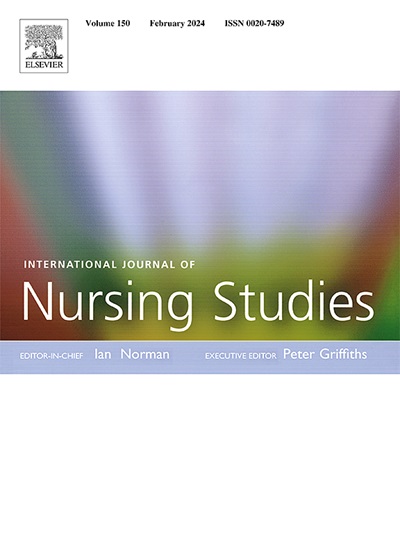Effectiveness of the nurse-led multi-component BRIDGE program on maternal competence and selected post-discharge outcomes of preterm babies: A randomized controlled trial
IF 7.5
1区 医学
Q1 NURSING
引用次数: 0
Abstract
Background
Mothers require sufficient knowledge and skill in caring for a preterm newborn at home after discharge. Infant weight gain and other health parameters can be used to assess the quality of care received. A comprehensive early intervention program can help mothers through this transitional period.
Objective
To examine the effect of the BRIDGE Program versus standard care in improving maternal competence and the selected post-discharge outcomes of preterm newborns admitted to the tertiary-level hospital in India.
Methods
We conducted a single-blinded, two-arm, randomized controlled trial with a repeated measures design. Participants were recruited from a tertiary-level multi-specialty medical college hospital and research center in Vijayapur, India. Overall, 110 preterm babies aged 32 to 37 weeks of gestation and their mothers were randomly allocated to either intervention or control group (55 preterm infants and mother dyad in each group). The BRIDGE program included five phases: (I) family-centered health education on prematurity and preterm care; (II) demonstrations of preterm care procedures such as breastfeeding and burping techniques, kangaroo mother care, oil massage, and so on; (III), a home care guide on DO.s and DON'Ts of preterm care; (IV) a home visit on first day of discharge; and (V) digital based follow-up through video call for one-week post-discharge. Outcomes were measured in terms of mothers' competence, preterm newborn weight gain, hospital readmission rate, and neonatal death up to one month after discharge. Data on mothers' competence in preterm care was collected at baseline and 7th-day post-discharge of preterm infants. For newborns, measurements were taken at baseline, discharge, seventh-day post-discharge, 15th-day post-discharge, and 30th-day post-discharge.
Results
After the BRIDGE program intervention, mean knowledge (95 % CI = 23.96–24.57) and skill (95 % CI = 14.02–14.69) scores of mothers in the intervention group has improved significantly than the control group (knowledge: 95 % CI = 18.20–20.60; and skill: 95%CI = 9.96–11.66). Preterm infants exposed to the BRIDGE program weighed 130 g and 790 g more than controls on days 15 and 30 after discharge (p = 0.016). However, no statistically significant differences were observed in readmission rate and post-discharge mortality of preterm infants (p > 0.05).
Conclusions
Although the BRIDGE program did not affect preterm infants' outcomes, the components of the intervention such as education, home visits, and digital follow-up empowered mothers allowing them to thrive in their surroundings and experience fewer consequences in newborn care.
Registration
The study was registered at the Clinical Trial Registry of India (Trial No. CTRI/2021/03/032349), and data was gathered between August 2021 and October 2022.
Tweetable abstract: The BRIDGE program to bridge the care of preterm from hospital to home setting can enhance mothers' competence and babies' growth in their environment.
护士主导的多组分BRIDGE项目对产妇能力和早产儿出院后结局的影响:一项随机对照试验
背景母亲需要足够的知识和技能在早产新生儿出院后在家照顾他们。婴儿体重增加和其他健康参数可用于评估所接受护理的质量。一个全面的早期干预计划可以帮助母亲度过这个过渡期。目的探讨BRIDGE项目与标准护理在提高印度三级医院早产新生儿产妇能力和选择出院后结局方面的效果。方法采用重复测量设计,采用单盲、双臂、随机对照试验。参与者是从印度维贾亚普尔的一家三级多专科医学院医院和研究中心招募的。总体而言,110名年龄在32至37周的早产儿及其母亲被随机分配到干预组或对照组(每组55名早产儿和母亲)。BRIDGE方案包括五个阶段:(I)以家庭为中心的早产和早产儿保健教育;(二)早产儿护理程序示范,如母乳喂养和打嗝技术、袋鼠妈妈护理、油按摩等;(III)有关DO的家居护理指引。早产儿护理的注意事项;(四)出院第一天家访;(五)出院后一周通过视频电话进行数字化随访。结果是根据母亲的能力、早产儿体重增加、再入院率和出院后一个月的新生儿死亡率来衡量的。在早产儿出院后的基线和第7天收集母亲早产儿护理能力的数据。对于新生儿,在基线、出院、出院后第7天、出院后第15天和出院后第30天进行测量。结果BRIDGE项目干预后,干预组母亲的平均知识(95% CI = 23.96 ~ 24.57)和技能(95% CI = 14.02 ~ 14.69)得分较对照组显著提高(知识:95% CI = 18.20 ~ 20.60;技能:95%CI = 9.96 ~ 11.66)。接受BRIDGE项目的早产儿在出院后第15天和第30天的体重分别比对照组重130克和790克(p = 0.016)。两组早产儿再入院率和出院后死亡率差异无统计学意义(p >;0.05)。结论:尽管BRIDGE项目对早产儿的预后没有影响,但干预措施的组成部分,如教育、家访和数字跟踪,使母亲能够在自己的环境中茁壮成长,并减少新生儿护理的后果。该研究已在印度临床试验注册中心注册(试验号:CTRI/2021/03/032349),数据收集于2021年8月至2022年10月。摘要:BRIDGE计划将早产儿的护理从医院转移到家庭,可以提高母亲的能力和婴儿在其环境中的成长。
本文章由计算机程序翻译,如有差异,请以英文原文为准。
求助全文
约1分钟内获得全文
求助全文
来源期刊
CiteScore
15.00
自引率
2.50%
发文量
181
审稿时长
21 days
期刊介绍:
The International Journal of Nursing Studies (IJNS) is a highly respected journal that has been publishing original peer-reviewed articles since 1963. It provides a forum for original research and scholarship about health care delivery, organisation, management, workforce, policy, and research methods relevant to nursing, midwifery, and other health related professions. The journal aims to support evidence informed policy and practice by publishing research, systematic and other scholarly reviews, critical discussion, and commentary of the highest standard. The IJNS is indexed in major databases including PubMed, Medline, Thomson Reuters - Science Citation Index, Scopus, Thomson Reuters - Social Science Citation Index, CINAHL, and the BNI (British Nursing Index).

 求助内容:
求助内容: 应助结果提醒方式:
应助结果提醒方式:


